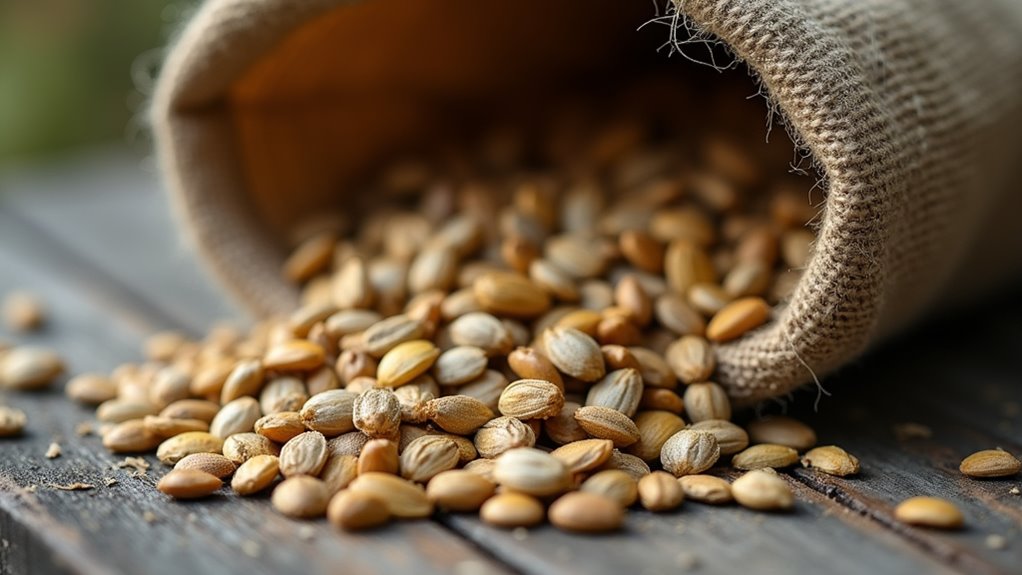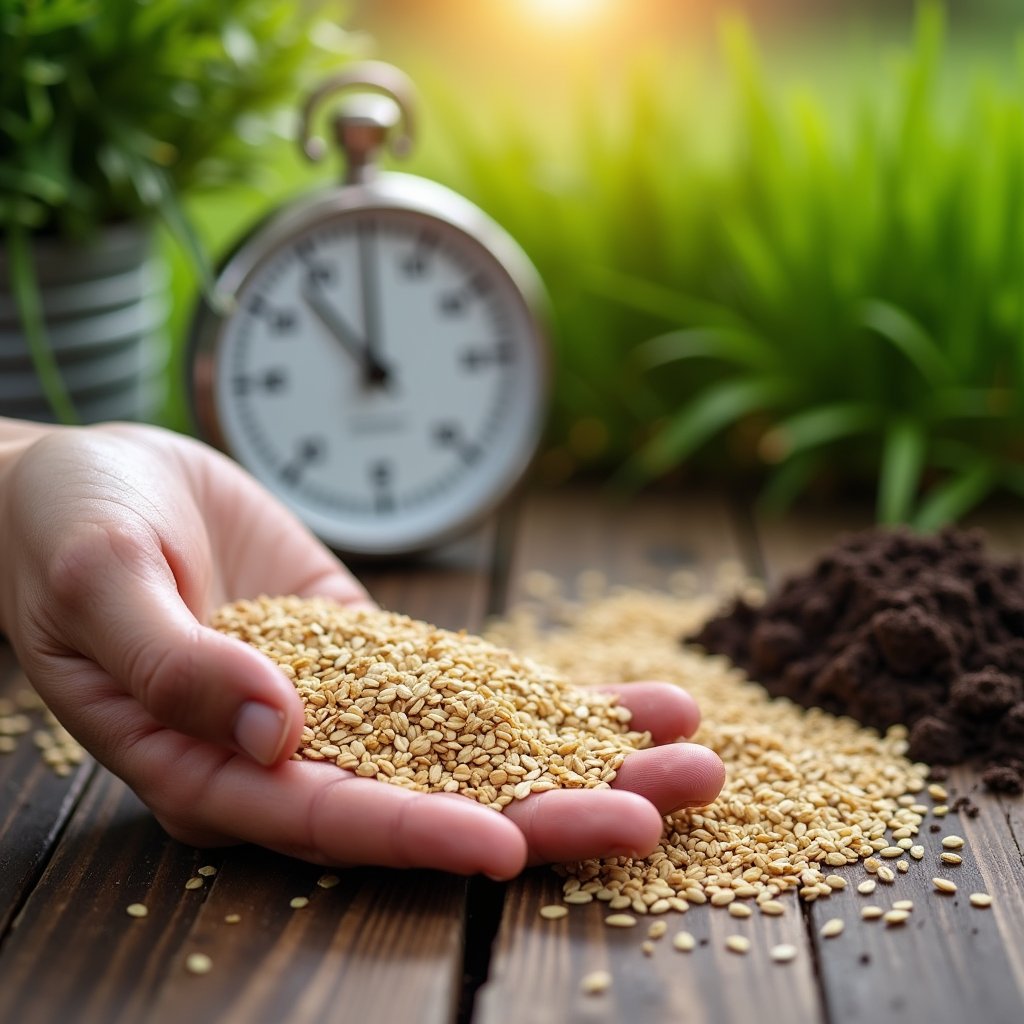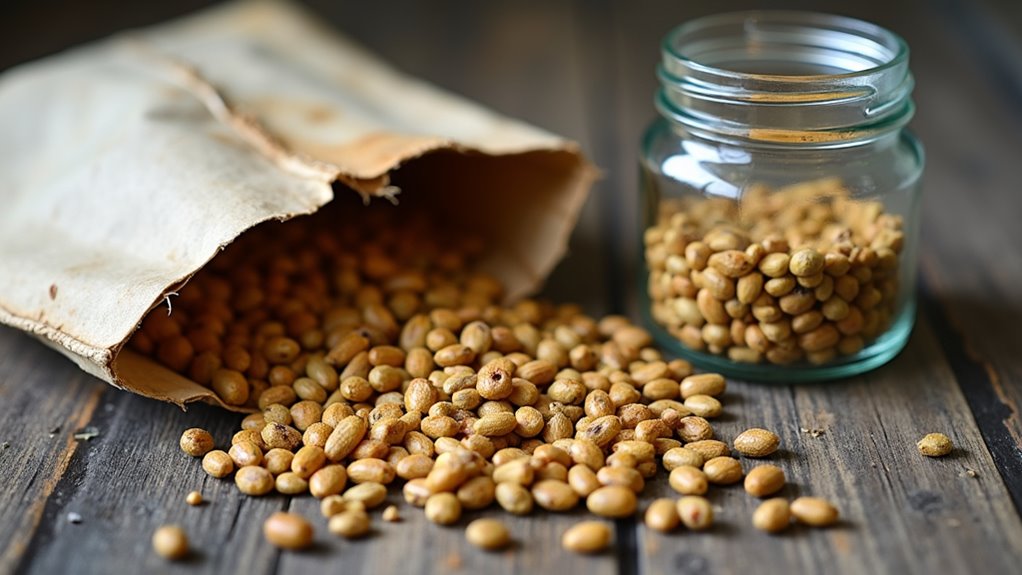Your grass seed will decline in viability over time, even with ideal storage conditions. Most varieties remain viable for 2-3 years, though perennial ryegrass can last up to 5 years when properly stored. To enhance longevity, you’ll need to maintain temperatures between 40-50°F and relative humidity below 40% in airtight, moisture-proof containers. Regular germination testing can help you monitor seed quality, with rates below 60% indicating significant deterioration. Understanding proper storage techniques guarantees your seed investment maintains its full potential.
Understanding Grass Seed Shelf Life

Although grass seed can remain viable for several years when properly stored, its germination rate gradually declines over time. You’ll find that different grass seed types demonstrate varying shelf lives, with Kentucky bluegrass typically lasting 2-3 years and perennial ryegrass maintaining viability for 3-5 years under ideal conditions.
Several seed viability factors influence longevity in storage. Temperature fluctuations, humidity levels, and exposure to light can greatly impact seed quality. You’ll need to monitor moisture content carefully, as seeds stored above 14% moisture are prone to fungal growth and premature deterioration. The initial quality of your grass seed also plays a vital role freshly harvested, properly cleaned seeds with high initial germination rates will maintain viability longer than poorly processed or mature seeds.
Optimal Storage Conditions for Grass Seed
You’ll need to maintain temperatures between 40-50°F (4-10°C) and relative humidity below 40% to preserve your grass seed’s viability during storage. Store your seeds in airtight, moisture-proof containers made of glass, metal, or heavy-duty plastic to prevent exposure to ambient moisture and pest infiltration. Keeping your stored grass seed in a dark location, such as a basement or climate-controlled garage, will protect the seeds from damaging UV radiation and temperature fluctuations that can trigger premature germination.
Temperature and Humidity Control
Maintaining precise temperature and humidity levels is critical for preserving grass seed viability during storage. You’ll need to protect your seeds from temperature fluctuations and maintain consistent humidity levels to enhance their longevity.
For ideal seed preservation, follow these essential controls:
- Keep storage temperature between 40-50°F (4-10°C), as higher temperatures accelerate seed deterioration and metabolic processes
- Maintain relative humidity at 30-40%, using desiccants or dehumidifiers to prevent moisture absorption that can trigger premature germination
- Store seeds in airtight, vapor-proof containers to minimize exposure to ambient humidity fluctuations and protect against condensation that forms when temperatures vary
Sealed Container Requirements
The proper selection of sealed containers directly impacts the effectiveness of temperature and humidity controls for grass seed storage. You’ll need containers made from moisture-resistant materials such as glass, metal, or high-density polyethylene (HDPE) to maintain ideal storage conditions.
Your container’s airtight sealing mechanism must create a complete barrier against external moisture and air. Look for containers with rubber gaskets or silicone seals that maintain their integrity over time. The container’s lid should lock securely with either a screw-top design or snap-lock clasps.
Choose containers that are appropriately sized for your seed quantity, as excess air space can lead to moisture accumulation. If you’re storing multiple grass varieties, use separate containers to prevent cross-contamination and maintain distinct storage conditions for each seed type.
Dark Location Storage Tips
Proper darkness levels play a critical role in preserving grass seed viability during storage. When you store grass seed in dark locations, you’ll protect the embryonic tissue and prevent premature germination that light exposure can trigger. Dark location benefits include extended storage duration and maintained seed dormancy.
- Store your grass seed containers in closets, basements, or dedicated seed storage rooms where ambient light remains minimal to non-existent.
- If using transparent storage containers, wrap them in opaque material or place them inside light-blocking bags to guarantee complete darkness.
- Monitor your storage area regularly to verify it hasn’t developed light leaks, as even minimal exposure can affect seed viability over time.
The darkness requirement becomes increasingly crucial when you’re planning long-term storage exceeding six months.
Signs Your Stored Grass Seed Has Gone Bad
Your stored grass seed can exhibit several warning signs of deterioration, including visible changes like discoloration, mold growth, or seed coat damage. You’ll want to conduct a simple germination test, where viable seeds should achieve at least 80% germination rate within 7-14 days under proper conditions. If you detect musty, sour, or rancid odors emanating from your seed storage container, these indicate potential moisture damage and microbial growth that have likely compromised seed viability.
Physical Appearance Changes
Monitoring stored grass seed’s physical appearance provides critical indicators of deterioration. As seed quality declines, you’ll notice distinct changes in color and texture that signal potential viability issues. Watch for these specific physical alterations:
- Seed color changes from the original hue to a dull, grayish tone, or development of dark spots and discoloration patterns indicating fungal growth or oxidative damage
- Seed texture alterations including brittleness, chalky surfaces, or unusual powdery coatings that weren’t present during initial storage
- Structural deformities such as cracking, splitting, or visible damage to the seed coat’s protective layer, often accompanied by internal kernel deterioration
These visual cues help you determine if your grass seed remains viable for planting or requires replacement to guarantee successful germination and establishment.
Germination Test Results
Beyond visual indicators, germination testing offers definitive evidence of seed viability decline. To conduct this test, you’ll need to place 10 seeds between moist paper towels, maintain them at 70°F, and monitor them for 7-10 days. Fresh grass seed typically achieves germination rates of 85-95%, while older seed shows progressively lower success rates.
If your stored seeds demonstrate germination rates below 60%, they’ve likely deteriorated considerably. You can compensate for reduced seed viability by increasing your seeding rate proportionally. For instance, if testing reveals 50% germination, you’ll need to double your normal seeding rate. However, when germination falls below 40%, it’s more cost-effective to purchase fresh seed rather than attempt to establish a lawn with poor-performing specimens.
Unpleasant Odors Develop
When grass seed begins to deteriorate, distinct musty or sour odors often signal the presence of mold, mildew, or bacterial growth. These unpleasant smells indicate serious storage issues that can render your grass seed non-viable and potentially harmful if used.
You’ll want to inspect your stored grass seed carefully if you detect any of these concerning odors:
- A fermented, alcohol-like smell indicating anaerobic decomposition
- A sharp, ammonia-type odor suggesting protein breakdown in the seed’s endosperm
- A dank, earthy scent revealing fungal colonization within the storage container
These olfactory indicators typically emerge when moisture levels exceed 14% or when temperature fluctuations create condensation. If you’re detecting any of these smells, you’ll need to dispose of the affected seed properly and review your storage conditions to prevent future deterioration.
How Different Grass Types Age in Storage
Different grass species exhibit distinct aging patterns during storage, with cool-season varieties generally maintaining higher viability compared to warm-season types. You’ll find that Kentucky bluegrass viability remains strong for 2-3 years when stored properly, while Fescue preservation can extend to 3-4 years under ideal conditions. Ryegrass storage typically maintains seed quality for 1-2 years.
Bermudagrass longevity tends to decline more rapidly, often showing significant deterioration after just one year in storage. You’ll need to monitor warm-season grass seeds more carefully, as they’re particularly sensitive to temperature and humidity fluctuations. To enhance storage life across all grass types, you should maintain consistent temperatures between 40-50°F and relative humidity below 60%. Testing germination rates annually will help you track each variety’s viability decline.
Temperature and Humidity Impact on Seed Viability

Temperature and humidity represent the two primary environmental factors that determine grass seed longevity in storage. You’ll need to monitor both humidity levels and temperature fluctuations to maintain seed viability. The ideal storage environment keeps seeds dry and cool, with consistent temperatures between 40-50°F (4-10°C).
For best seed preservation:
- Maintain relative humidity below 40% to prevent moisture absorption and fungal growth
- Store seeds in airtight containers to shield them from ambient temperature fluctuations
- Check storage conditions regularly using a hygrometer and thermometer to guarantee stability
When seeds are exposed to high humidity or temperature variations, they’ll consume more stored energy through increased respiration, reducing their germination potential and overall viability. Even brief exposure to unfavorable conditions can trigger physiological changes that compromise seed quality.
Testing Stored Grass Seed for Germination
Before planting stored grass seed, you’ll need to evaluate its germination potential through standardized testing procedures. To conduct a basic germination test, place 10 seeds on a damp paper towel, fold it over, and seal it in a plastic bag. Store the bag at 70°F (21°C) in a location with indirect light.
Check the seeds daily for sprouting activity over a 7-14 day period, keeping the paper towel consistently moist. Count the number of seeds that successfully germinate and calculate the germination rate percentage. Professional seed viability testing techniques may include tetrazolium chloride staining or controlled growth chamber trials. If your seeds show less than 60% germination, you’ll need to increase your seeding rate or consider purchasing fresh seed to achieve ideal lawn establishment.
Best Practices for Long-Term Seed Storage

When storing grass seed for extended periods, maintaining ideal environmental conditions is critical for preserving seed viability. Your storage duration can extend beyond a year when you properly control temperature, humidity, and protect against pests.
- Keep seeds in airtight seed packaging at temperatures between 40-50°F (4-10°C), and maintain relative humidity below 40%. A refrigerator’s crisper drawer provides an ideal environment.
- Store seeds in opaque, moisture-proof containers. If using original packaging, place it inside a sealed glass jar or food-grade plastic container to create a double barrier against humidity.
- Monitor storage conditions regularly. Check for condensation inside containers, inspect for signs of rodents or insects, and verify stable temperature readings. Remove any damaged or infested seeds immediately to prevent contamination.
Common Storage Mistakes to Avoid
While proper storage techniques preserve grass seed viability, certain missteps can rapidly diminish seed quality and germination rates. You’ll want to avoid these critical storage errors that commonly lead to seed deterioration.
| Storage Mistake | Negative Impact |
|---|---|
| Improper sealing | Allows moisture infiltration and pest entry |
| High humidity exposure | Triggers premature germination |
| Temperature fluctuations | Reduces seed longevity and vigor |
| Direct sunlight | Degrades seed nutrients and enzymes |
| Moisture exposure | Promotes mold and fungal growth |
Don’t store seeds in areas prone to temperature swings, such as garages or outdoor sheds. Ascertain containers are completely airtight even minor gaps can lead to devastating moisture exposure. You should also avoid storing grass seed near chemicals, fuels, or pesticides, as vapors can contaminate and damage seeds through permeation.
Frequently Asked Questions
Can I Mix Old Grass Seed With New Seed When Planting?
You can mix old and new grass seed, but you’ll need to account for reduced seed viability in the older batch. As grass seed matures, its germination rates decrease, which means you’ll need to adjust your seeding density. For best results, increase the total seeding rate by 20-50% when incorporating older seed to compensate for lower germination potential. This guarantees adequate coverage while maximizing the success of both old and new seeds.
What Happens if Animals Eat Expired Grass Seed?
When animals consume expired grass seed, they’ll typically experience minimal health risks. The seeds’ digestive properties remain relatively stable even after expiration, though nutritional value may decrease. Your main concern should be potential mold growth on old seeds, which could cause digestive issues or mild toxicity in animals. While most expired grass seeds pass through an animal’s system without harm, you’ll want to prevent access to visibly moldy or deteriorated seeds.
Is It Safe to Compost Grass Seed That Has Gone Bad?
“One person’s trash is another’s gem” rings true regarding expired grass seed. You’ll find it’s completely safe to compost old grass seeds, as natural seed degradation processes align perfectly with composting benefits. The seeds’ organic matter will break down, contributing valuable nitrogen and carbon to your compost pile. Even if some seeds remain viable, they’ll either decompose or potentially sprout, adding green material to your compost mixture.
Can Grass Seed Be Stored in the Freezer to Extend Shelf Life?
You can store grass seed in your freezer to extend seed longevity, but you’ll need to follow specific freezing methods. Initially, verify the seeds are completely dry and sealed in an airtight container to prevent moisture damage. Store them at a consistent temperature between 0°F and -10°F. While freezing can preserve viability for several years, you should gradually thaw the seeds at room temperature before use to prevent cellular damage.
Will Old Grass Seed Affect the Growth of Newly Planted Seeds Nearby?
No, mature grass seed won’t negatively affect the planting success of your new seeds. While aged seeds may have reduced seed viability and won’t germinate as effectively, they don’t release harmful substances or inhibit the growth of nearby viable seeds. You’ll simply notice patchy growth in areas where old seeds failed to sprout. For ideal results, you should remove any visible non-germinated seeds before reseeding to guarantee even coverage.


No responses yet